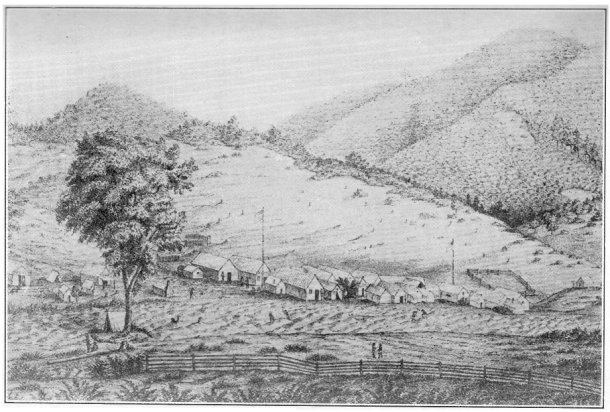
[click to enlarge]
The tent town of Agua Fria, in 1849.
[Editor’s note: from p. xi: The tent town of Agua Fria, in 1849. The Exchange Hotel is on the extreme left. The ground in front of the houses is all dug up in piles for washing. —dea].
| Online Library: | Title | Author | California | Geology | History | Indians | Muir | Mountaineering | Nature | Management |
Yosemite > Library > Call of Gold > 1. An Indian Wilderness >
Next: 2. Gold Seekers • Contents • Previous: Prologue
Previous to the year 1849, practically no white people had ever visited, or known about, the domain now called Mariposa County, California. The hills everywhere were covered with the finest timber, wild game was plentiful, and the streams were well supplied with speckled trout.
Numerous tribes of Indians inhabitated the area and they were expert with their bows and arrows. How many centuries they and their ancestors had roamed these hills, no-one knows, as no permanent monuments had ever been built by them. Their trails were hardly more than those of the deer; and their huts, made of brush, bark, and mud, lasted but a short time.
Nature supplied them with everything necessary. Their only clothes were trunks or breeches, made of the hides of the deer, bear, or fox; while occasionally, in the coldest weather, a few wore jackets, similarly made. They could prophesy the severity of the coming winter by the behavior of the animals. If the woodpecker buried his acorns deeper in the tree or the mud-daubing swallows made new nests higher up on the river’s bluff, they knew a severe winter was coming and prepared for it.
They lived on meat from the wild animals, fish, acorns, pinenuts, wild berries, and worms. Fish were caught with traps made from the willow. These traps had about a three foot opening at the mouth, placed up-stream; while the down-stream end was narrower and raised out of the, water, so that the force of the current would wash the fish into the dry end of the trap. String and rope were made from the milk-weed and were used in trapping squirrels, rabbits, and quail.
Their smoking pipes were made of elder berry Wood, three or
Occasional quarrels with other tribes furnished excitement and occupied some of their spare time, but were settled without the aid of lawyers or courts. These Indians knew practically nothing of what was going on in the rest of the world, but things were happening.
Next: 2. Gold Seekers • Contents • Previous: Prologue
| Online Library: | Title | Author | California | Geology | History | Indians | Muir | Mountaineering | Nature | Management |
http://www.yosemite.ca.us/library/call_of_gold/indian_wilderness.html